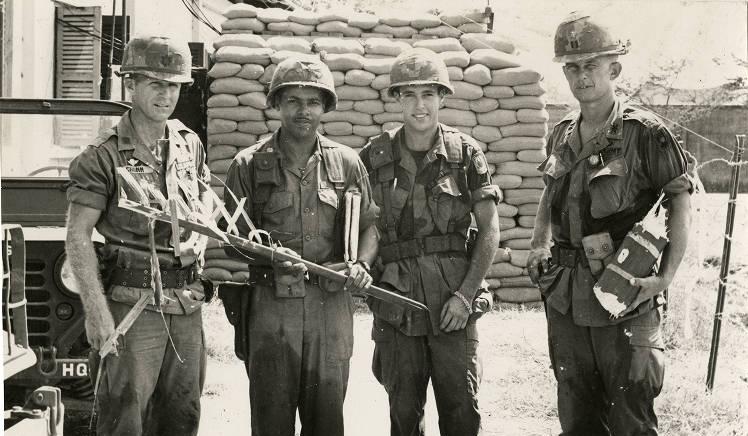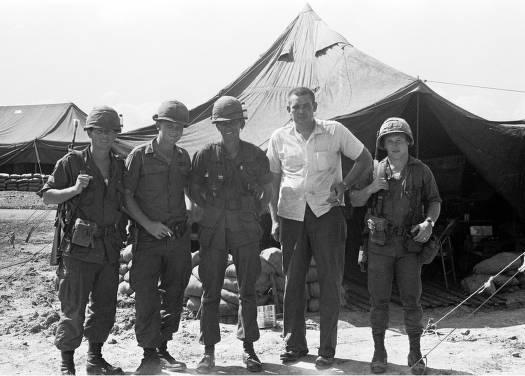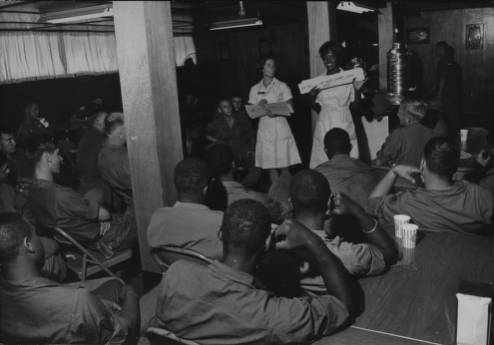The Vietnam War divided Indianapolis as no conflict had since the Civil War. The city experienced its first antiwar demonstrations in 1964 when police arrested 20 marchers on . Despite this early protest, Indianapolis remained generally supportive of the war during its early years.

Even the city’s colleges and universities remained quiet into the mid-1960s. In December 1965, the state’s university students presented a petition from the Student Committee for the Defense of Vietnam to Governor Roger Branigin at the State House. Led by students at the Indiana University Law School in Indianapolis, the group urged a “policy of strength against the Viet Cong and oppos[ed] Vietnik demonstrators.”
If more antiwar sentiment was expressed locally in the early years of the war, Indianapolis newspapers did not report it. When President Lyndon B. Johnson visited the city in 1966 the , in its report on the “thousands of cheering, screaming Hoosiers” who welcomed him, carried only a brief mention of the 30 young antiwar demonstrators who were arrested for disturbing the peace before Johnson arrived.
Many of the city’s residents and most of its media were clearly pro-war. Although local papers did not report the views of antiwar “doves,” they devoted much editorial space to attacks on antiwar sentiment. In November, Alan M. Simons, organizer of “Vietnam Summer: Indianapolis Project (VIP),” an affiliate of a national program to promote peace in Vietnam, condemned the local papers for ignoring news “they disapprove of,” such as the VIP project. He claimed there was a “great deal of latent sentiment for peace” in Indianapolis.
The and the , both published by , one of the city’s most vocal hawks, took strong stands in favor of the war. On July 26, 1967, the Student Committee for Victory in Vietnam named , the ’s editor, honorary chairman of their pro-war movement in respect for his support of the conflict.

A sincere concern for the future of American freedom fueled the anticommunist passion of the hawks. Although South Vietnamese freedom from communism lay at the heart of the struggle, war supporters believed that communism’s spread threatened everyone. They condemned the anti-war protests as the work of pacifists, leftists, and communists.
Despite media condemnations, doves believed fervently in the cause of peace. They protested the futility of a war that they believed could not be won and emphasized the mounting casualties of the conflict. In May 1967, the nearby Plainfield Friends Church conducted programs about the draft and offered counseling for conscientious objectors.
Local citizens became involved with the war in a myriad of ways. The Lawrence Lions Club produced a four-page newsletter full of community news for servicemen from that city. On July 7, 1967, the conducted a pro-war parade in which 12,000 people participated and 30,000 watched. Floats constructed by and the won the governor’s cup and the national commander’s cup, respectively. Local radio personality took his “Pick-A-Pocket” show to the troops in Vietnam.
After the sixth year of the war, in May 1968, the United States began peace negotiations with North Vietnam. Sentiment in Indianapolis, even among hawks, welcomed the possibility of an end to the war and the divisions at home, both of which were nightly fare on national news broadcasts. Although the noted that Marion County’s war death toll was lower than elsewhere in the state, standing at 107 men, the erection in 1968 of a mock Vietnam village used to train soldiers at reminded citizens that the war was still raging. In June, the Board of County Commissioners ordered the American flag in front of the City-County Building flown at half-staff each Wednesday in commemoration of the men fighting in Vietnam.

By 1969, 34,000 servicemen and women had died in Vietnam. On July 4, 20 members of the antiwar Draft Project, headquartered at 222 East 16th Street, gathered on the steps of the Federal Building and read the name of each U.S. fatality as a testimony to “all the men of many nations who have had their lives taken from them in the Vietnam conflict.”
The nation’s first “Vietnam War Moratorium Day” took place in October 1969. Tens of thousands of war protesters marched on Washington, D.C. In Indianapolis, although protest was still unsanctioned by the city’s press and many citizens, it received news coverage. A rundown of local moratorium events was included in an article that cited South Bend’s University of Notre Dame and Quaker-operated Earlham College in Richmond, Indiana, as the sites of most antiwar activity in the state.
In Indianapolis, held a candlelight procession and memorial service, and both Butler and sponsored forum discussions about the war. students commenced a 24-hour peace and fasting vigil. their counterparts at rallied on the lawn in front of the Student Activities Center.
The Indiana Mobilization Committee distributed end-the-war leaflets in city high schools from its base of operations at . However, a public opinion poll conducted by the after the moratorium indicated “overwhelming popular approval of standing by America’s commitment” in Vietnam, 45 percent of respondents favoring President Richard Nixon’s position of “seeking an honorable end to the war.” Another 40 percent wanted to resume bombing in pursuit of a military victory. Only 15 percent favored an immediate end to the conflict. The editorial staff cited these results in support of the claim of Vice President Spiro Agnew that demonstrations were not a popular mandate to end the war.
In May 1970, after National Guardsmen fired on student protesters at Kent State University in Ohio, killing four, Butler students conducted a mock funeral for the victims. Seven hundred and fifty students marched from to the Federal Building, some waving the North Vietnamese flag.
In spring 1971, many Indianapolis area residents protested the conviction of Army Lt. William Calley for the premeditated murder of South Vietnamese civilians at My Lai by signing petitions and contributing money to the lieutenant’s appeal fund. Two Indianapolis women set up a booth on the steps of Christ Church Cathedral and in a jeep parked in a vacant downtown lot and collected 2,500 signatures on pro-Calley petitions and $600 in donations. A local man offered to post a $100,000 bond for Calley’s release pending appeal and Governor Edgar Whitcomb ordered the flag on the State House to be flown at half-staff.
By that summer, Indianapolis’ experience with the war entered a new phase. As the United States withdrew from the conflict, concern over POWs and MIAs emerged. The local Sertoma club collected thousands of letters asking for humane treatment of POWs by the North Vietnamese and in July sent a delegation of 12 central Indiana residents to Paris to present the letters at the Paris peace talks. Two local Jaycees groups sold POW bracelets, each engraved with the name of one POW or MIA. The names of Indianapolis residents Major Carl W. Lasiter and Colonel James Kasler were among those listed as POWs on bracelets worn by citizens.
In March 1973, President Nixon ended American military operations in Vietnam. Mayor opened a Veterans Administration Center at 36 South Pennsylvania Street, one of 20 in the nation, designed to help new veterans obtain benefits and services. But veterans locally and nationally resented the country’s lack of recognition for and belittlement of their efforts in the controversial war.
In 1975, when the South Vietnamese government fell, Indianapolis quickly joined the effort to offer aid to Vietnamese refugees. Citizens adopted orphans and even entire families in the “tidal wave of concern” that swept the country. But by August 1975, that sentiment subsided, and although members of Gethsemane Lutheran Church, Holy Spirit Catholic Church, and Irvington Friends Church joined to bring a Vietnamese family to Indianapolis, the community at large donated only $100.
The legacy of the Vietnam War persisted into the 1980s and 1990s. In 1987, the Indiana legislature authorized the construction of a Vietnam War memorial, to be built with private funds, in honor of Indiana citizens who lost their lives in Southeast Asia.
However, it was not until 1996 that Governor Evan Bayh dedicated such a memorial. The Indiana Vietnam War Memorial is accompanied by a and memorials at the in downtown Indianapolis. Designed by Indianapolis architect Patrick Brunner, the names of 1,533 Hoosiers are inscribed on the Indiana limestone cylinder, 215 of them, including 13 MIAs, from Marion County.

Help improve this entry
Contribute information, offer corrections, suggest images.
You can also recommend new entries related to this topic.